ODDBALL SCHEMES & MARKINGS – Hasegawa Fw-190A-5
The Airplane:
The Fw-190A series was so right in design that - once the problem of providing adequate cooling for the BMW 801 radial engine was solved - the airframe went through little modification other than minor changes associated with changes in armament.
The one major change between the early subtypes A-1 - A-4 aircraft and the later series following the A-5 subtype involved a change in the engine mount for center-of-gravity problems associated with use of various armament fittings. This lengthened the forward fuselage 5.9 inches, just ahead of the wing leading edge.
The Fw-190A-5, which maintained the armament of the A-3 and A-4 sub-types of two MG17 7.62mm machine guns in the forward fuselage, two MG151 20mm cannon in the wing root and two MG-FF 20mm cannon in the outer wing position, replaced the A-4 in production in April 1943. The Fw-190A-5 was phased out of production in June 1943 in favor of the Fw-190A-6 which differed in having a modified wing with a lighter structure and the outboard MG-FF cannon replaced by the far superior MG151.
Both the A-5 and A-6 subtypes remained in service on the Eastern Front well after the introduction of the heavier and more heavily-armed A-8 subtype, because their light weight and superior maneuverability was needed in the low altitude fighter-versus-fighter air combat found on the Eastern Front, where the heavy armament of the A-8 - so necessary in opposing the American heavy bombers - was not needed. The last of these sub-types did not leave service with JG 54 until the end of 1944, and that was primarily due to their being worn out in operations.
Emil “Bully” Lang - Wurger Experte:
While the Fw-190A series rapidly became the fighter of choice among the Channel Front Jagdgeschwader, none of the Eastern Front jagdflieger received the aircraft until JG 51 - based in the Central Sector - was re-equipped with Fw-190A-3s and A-4s in November 1942. I and II Gruppen of JG 54, the Greenhearts Geschwader, began re-equipment in December 1942, with final changeover from the Bf-109G-2 completed in February 1943.
At this time, the Greenhearts were assigned to Luftflotte 1 on the Northern Front, based at Siverskaya and Krasnogvardiesk in the vicinity of Leningrad. The Northern Sector had become static in September 1941, when the city was first surrounded and the Wehrmacht began the legendary 900-day siege. JG 54 would be the only Jagdgeschwader on the Eastern Front to remain equipped with the Fw-190A throughout the war, ending their service cut off from the rest of the German forces in the Courland peninsula of Estonia, a position they held for the final six months of the war.
The Jagdflieger of JG 54 were not as immediately impressed with Kurt Tank's “second iron in the fire” as their Western Front brethren, with one leading pilot saying the airplane “landed like a wet sack of flour.”
Hauptman Emil “Bully” Lang was a bit old for a fighter pilot at 33, having had a prewar career with Lufthansa prior to joining the Luftwaffe on active duty following the outbreak of the war. He had in fact had to fight his way into the Jagdwaffe, claiming his place by demonstrating his outstanding flying ability. Joining JG 54 during the Battle of Britain, Lang soon established himself as not only an outstanding pilot but an experte of the first rank and was the senior Staffelkapitaen at the time II Gruppe transferred to the Fw-190.. As a qualified test pilot, Lang decided shortly after taking delivery of his Fw-190A-4 and returning with it to Siverskaya to see what the airplane was really capable of. He took it to its maximum altitude, wallowing at 27,000 feet, then rolled and aimed the nose straight down in a terminal-velocity dive. The dive was so long that the propeller arc became a dive brake as the airplane achieved its absolute maximum speed somewhere in the vicinity of 600 mph. It took all of Lang's considerable strength (his nickname came from his size) to pull the stick back sufficiently to pull out without hitting the ground. Back at the base, the other pilots gathered around to count the missing rivets in the wing root and recheck the dihedral, only to find all rivets resolutely unpopped! Lang's dive was the ultimate confidence-builder for the unit.
Operation Zitadelle - known to history as The Battle of Kursk - was Hitler's last gamble to change the course of the war in the East. At first only I/JG 54 was moved to the Central Sector to reinforce JG 51 and provide air superiority over the battleground. On July 5, 1943, Oberstleutnant Hannes Trautloft - the original Kommodore of JG 54 - handed over command to Major Hubertus von Bonin. II/JG 54 remained on the Leningrad front for the time being. The battle began on July 5, with the Fw-190s of both JG 51 and JG 54 scoring well. By July 10, the ominous outcome of the battle began to take shape as Russian aerial opposition hardened, with Soviet fighter regiments mounting their own “free hunt” sweeps over the front, attacking forward German fighter fields relentlessly. On July 11, I/JG 54 Kommandeur Major Sepp Seiler was shot down and killed. Gunther Scheel, a71-victory experte, was lost in combat and he rammed a Yak-9 near Orel on July 17.
Aerial combat also increased around Leningrad, with II/JG 54 suffering losses. Gruppenkommandeur Hauptmann Heinrich Jung was lost on July 30. 82-victory experte Heinz Goetz, brought from the Mediterranean to replace Sepp Seiler was lost in combat over Orel on July 31, only 5 days after taking command of I Gruppe.
Following the collapse of the German offensive in mid-July and the stabilization of the front near Orel, 61 Soviet divisions struck the Ukraine front in August, rolling up the exhausted Wehrmacht, and expanding the offensive against Yelnya, Smolensk and Velizh to the north while hitting Poltava and Kharkov to the south, and the entire Ukraine beyond. From this point onward, the Soviet offensive would be unrelenting, maintaining full fury against the Germans until early 1944 when the last units were driven off the territory of the Soviet Union.
Both Gruppen of JG 54 were now shuttled back and forth between the Northern Sector and the northern part of the Central Sector. Hugely outnumbered by the Red Air Force, those experten
who managed to survive ran up huge scores, often ten or more in a single day, as they flew up to four missions between dawn and dusk. Lang built his tally during this period with numerous combats in which he made multiple victory claims.
Lang's greatest day came on October 18, 1943, when he took off leading a schwarm for a dawn patrol over the central front. Spotting a formation of Il-2 Stormoviks escorted by P-39 Airacobras, Lang dove for the attack, shooting down four P-39s in as many minutes. He then shot another off his wingman before shooting down two of the heavily-armored Sturmoviks for a total seven victories in the one mission. Later that day he intercepted another Russian formation and tore into the escort, shooting down a further six. In a final mission in the late afternoon he once again came across a huge Russian formation and shot down five more P-39s, for a total of 18 victories in three missions in one day - the all-time world record for a fighter pilot. While his score is impressive, it is a measure of just how overwhelming the Soviet numerical superiority was that Lang's feat had no influence on the outcome of fighting that day, as Stormoviks and Pe-2s tore into German armor all along the front and hundreds of other P-39s, P-40s, and other Soviet fighters strafed German positions with impunity.
Lang received the Swords to his Knight's Cross in January 1944 for this feat. In June 1944, having achieved 159 victories during his years of service with JG 54, he was transferred to the Normandy front to take command of II/JG 26. Flying his first mission on June 9, he shot down three Spitfires over Caen. Lang led the Gruppe through the chaos of the Battle of Normandy, extricating the Gruppe to Germany by the end of July. He spent the first two weeks of August training the new pilots who replaced the many lost in France. Many of the pilots in the Gruppe were Nachwuchs (new growth), young pilots like Obergefreiter Walter Stumpf who entered combat that month with 180 total flying hours, of which he had 20 hours on Bf-109s and Fw-190s. He and his fellow youngsters were going up against RAF pilots who entered combat with at least 450 hours' experience, and Americans who started with 600 hours.
II/JG 26 returned to operations in time to take part in the last of the fighting over France, including an all-out fight with the Spitfires of 127 Wing RCAF, led by Wing Commander Johnny Johnson on August 23, in which Lang scored two of the three Spitfires shot down, while losing ten Nachwuchs to the experienced Canadians. On August 25, as Paris was being liberated, Lang led a freie jagd of 32 Fw-190s, spotting a formation of 24 P-38s from the 474th Fighter Group which had just been hit by Bf-109s of III/JG 26. Lang scored one P-38 in the first pass, and then two more of the total 11 P-38s lost by the 474th to II Gruppe, who returned to base without loss; August 25th became known as “Black Friday” to the surviving Lightning pilots.
On September 2, 1944, Lang was to lead II Gruppe in their final retreat into Germany, a flight from Moelsbroek, Holland, to Dusseldorf. Lang's Fw-190 had been giving him trouble, and his schwarm was the last of the unit to take off. Ten minutes after takeoff, his long-serving wingman, Leutnant Alfred Gross, called out bandits to the rear. As Lang broke upward, the four Fw-190s were hit by 16 P-51s from the 38th Fighter Squadron of the 55th Fighter Group. 1st Lt. Darrel Cramer turned onto Lang's tail, pulling 78 degrees of deflection as he leaned into his K-14 sight.
“I was closing fast, and turned off a little to the left to get further from his line of flight and reduce the angle-off. I turned in hard right and opened fire from 300 yards. When I ceased firing at 200 yards, the aircraft went out of sight below my nose because of the lead I was pulling. I broke up and came around. I saw the Fw-190 upside down in a step dive. It hit the ground so hard that it generated shock waves along the ground like a rock makes when it is thrown into a pond. It skidded a few yards and blew up in a fireball.”
The other members of Lang's Stabschwarm were quickly overwhelmed by the Mustangs, only Unteroffiziere Borreck survived his crash to tell the rest of the Gruppe what had happened to their Kommandeur.
At the time of his death, Lang had scored 173 victories, including 25 scored in the cauldron of France with II/JG 26. At age 35, he was the oldest active pilot in the Jadgwaffe.
The Kit:
The Hasegawa Fw-190A series in 1/48 first came out around 1994, when the Fw-190a-4 arrived. Since then, all A-model sub-types were released by 2000. The overall kit is a development of the Dragon Fw-190A, which Hasegawa licensed. The kits have been out of production for many years, but can still be found at decent prices on eBay. The kit has been considered passe since the arrival of the new-mold Eduard Antons in 2015.
Construction:
With care, the Hasegawa 190s can be built without need of putty. Like the Dragon kit it is developed from, the one place you need to worry about fit is when bringing the fuselage and wing sub-assemblies together. The fuselage needs an internal brace under the rear of the cockpit tub to insure it is spread sufficiently so the upper wing and fuselage can join without a gap. The spreader can be made from sprue, and just needs test fitting to insure all is tight before applying glue.
I had photo-etch from an early Eduard Fw-190 kit for the cockpit and used it on this model.
Painting:
Trying a new camouflage color pattern was my primary reason for doing this old kit. Most color references for JG 54 tri-color camouflage is tan, and dark and light green. I found a color photo though, in which the light green area looked more like RLM 02. Putting the three colors together, it seemed to me this would be a good air-to-air camouflage over the northern Russian forest, where JG 54 operated, and I decided to try it.
After preshading the model along panel lines, I painted the yellow areas under the cowling and wingtips and around the rear fuselage and rudder, then masked that off. I painted the lower surfaces RLM 76 Lichtblau, then painted the upper surfaces overall RLM 02. I then painted blotches of RLM 70 Schwarzgrun, and RLM 79 Desert Tan. The final result was close to the photo, and while it looked different since I was used to the RLM 02 being a light green, it did appear it would be an effective air combat camouflage.
Decals:
I used decals from the Aeromaster JG 54 Special sheet.
Final assembly:
After doing Eduard kits that have no problem with attaching the main gear in the correct position, I fiddled with the alignment of the main gear for this kit. If you get it so that the axle of the main gear is just in front of the leading edge of the wing, looking straight down on it, you have things “close enough.”
Overall:
This was an interesting experiment with camouflage colors, and a nice reminder that just because a kit is old doesn't mean it isn't still good. The Hasegawa Fw-190s make up into nice models that can stand being sat next to the new Eduard kits for comparison.
Review kit courtesy of my wallet long ago.
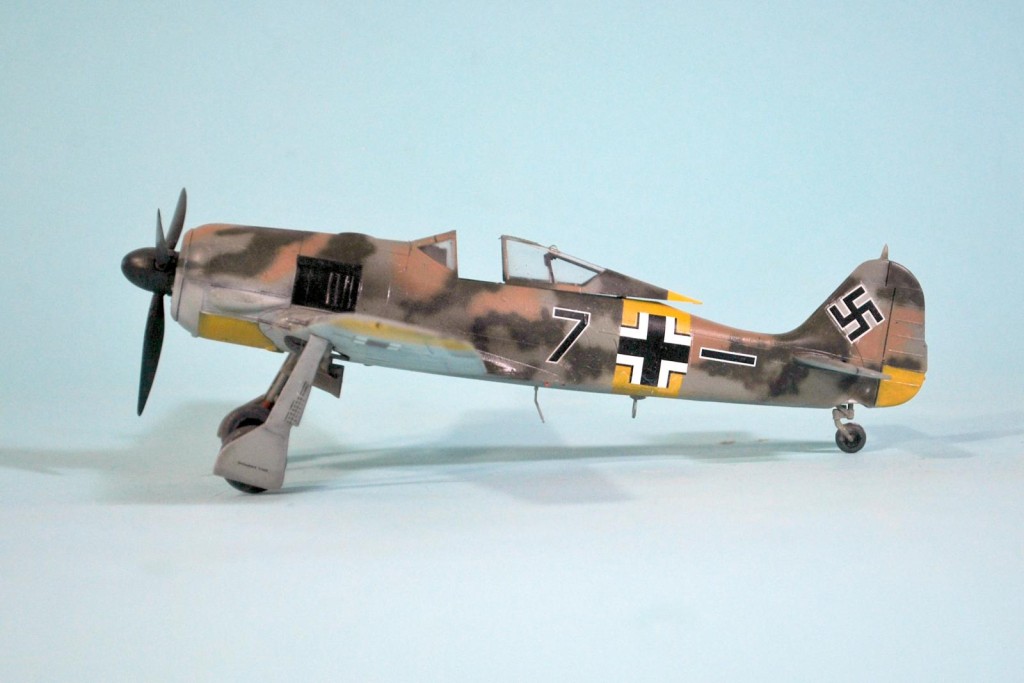
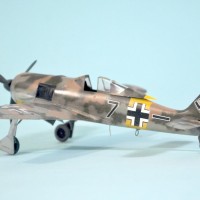
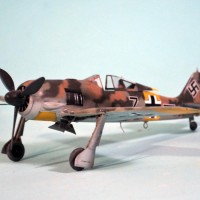
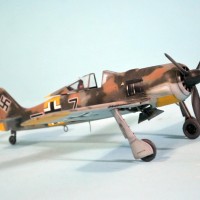
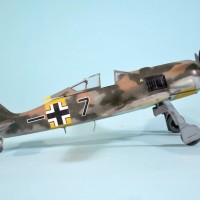
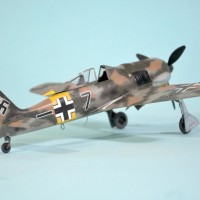
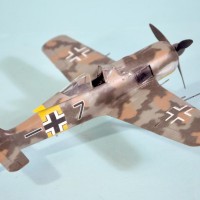
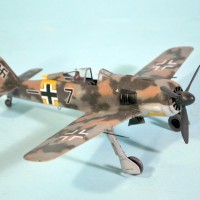
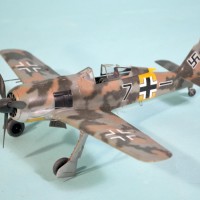
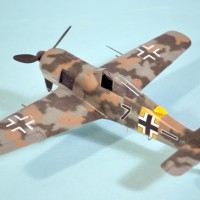
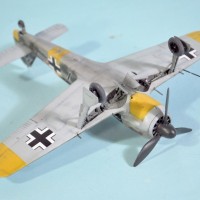
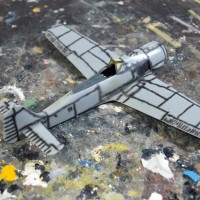
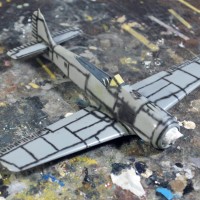
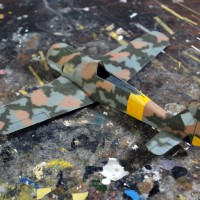
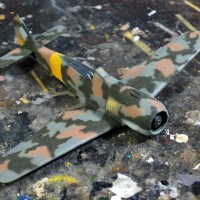
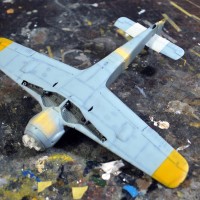
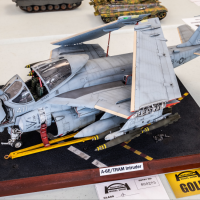
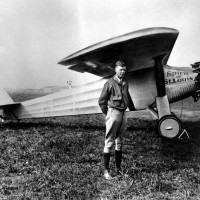
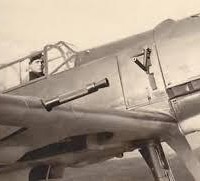
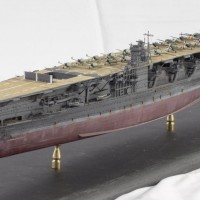
great Painting scheme! I like it!
Great story as usual Tom @tcinla, always learn some new facts about the pilots behind the machines you depicted. In this case there were several, including the vague idea I had in the back of my mind that Lang had been shot down by P-47s not Mustangs. That was in fact Egon Mayer…
Beautiful work on the camouflage, very fine spraying. And I absolutely agree with your opinion regarding Hasegawa 190 kit, if you have one on the stash it’s a very worthy build. Any average skill modeller can get the best out of the plastic with this one.
Love that scheme Tom !
Nicely done, Tom.
Excellent work on the camouflage and the entire build as well, Tom @tcinla
Its effectiveness is clearly visible on your table top.
Thanks for sharing the history of Lang, a very nice to read article.
Loved the model and story, Tom!
Excellent spray job indeed. "Old" Hasegawa's still hold up well.
Great article @tcinla and a good looking 190 as well! Did you paint that with your Paasche H? ?
Always!
Excellent paintwork, Tom. BTW, I’m enjoying Tonkin Gulf. Well done as well!
1 attached image. Click to enlarge.
Love to see that, @j-healy. Leave a review at Amazon when you're done, please. The other half, "Going Downtown" came out this past Tuesday.
1 attached image. Click to enlarge.
I just took a break from using my old Paasche H just a few minutes ago, so I could admire your latest work here, @tcinla. Isn't it amazing what these trustworthy old single action Paasche H's can do? You're proof of that, Tom.
Built like a tank. 50 years of practice, I'm finally pretty OK with it. 🙂
If you follow my builds, you know I like unusual paint schemes, so I love your interpretation of this! I may have to follow suit in a 1/72 build in the near future. I'm not as big a fan of the 190 as I am of the 109 (just from an aesthetics viewpoint) so I don't have as many of them in my stash, but I certainly have enough to use this scheme on one of them!
By the way, my dad flew F-4's out of Cam Ranh Bay - any coverage from there in your new book? (I'll buy it anyway, but just wondering. Not many accounts of the 559th out of Cam Ranh in print anywhere...)
The story of the Rescue at Ban Phanop involves Cam Ranh Bay F-4s.
Hasegawa 190's are definitely nice kits and you did justice on yours.
Very nicely done Mr. C.
Another one of your deep researches and an excellent work. Thanks for sharing.